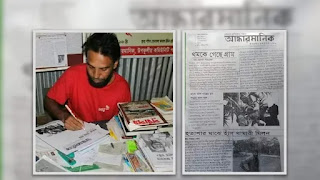A total of 16 journalists, all of whom are manual laborers, work for this newspaper. Some of them are brick kiln workers, farmers, fishermen, and even physically challenged people. The surprising thing is that the editor of this newspaper is a brick kiln worker. I am talking about the coastal community newspaper Andharmanik, where the sad and happy stories of the ordinary people working in the village are published.
The newspaper is published from West Sonatala village of Nilganj union in Patuakhali’s Kalapara upazila. This four-page newspaper started its journey on May 1, 2019. Mohammed Hasan Parvez, a resident of West Sonatala village, is in charge of the editor. He lives in a small house with his two daughters and wife, but he is not the owner of the piece of land on which he built the house. That is, he is living on another person’s land. The owner of the land has informed Hasan that he will sell the land if required. According to Hassan, since he has no money, he might have to leave West Sonatla village very soon for another village. Despite such a financial condition, such a person took the responsibility of a newspaper on his shoulders just as a hobby.
Mohammed Hasan Parvez said that he has been writing stories and poems for a long time, but no newspapers ever published his writing, which upset him very much. Suddenly, one day, he met Rafiqul Islam Montu, a coastal journalist, and told him about this matter. He advised Hasan Parvez to open a community newspaper. The newspaper, Andharmanik, is named after the river that flows beside the village. As the stories of happiness and sorrow of the common working people of the village were published from the very beginning of the Andharmanik newspaper, it did not take much time to take place in the minds of the people.
Almost all the people who are working as news correspondents for this newspaper on a voluntary basis are low-income day laborers. When they go to sell their labor in other people's houses, they hear the stories of happiness and sorrow of different people in the village and write them down and send them to Mohammed Hasan Parvez, the editor of Andharamanik. Mohammed Hasan Parvez uses as much time as he gets in the evening or at night after finishing his work as a laborer. Only the news headlines are printed, and the rest is handwritten. The handwritten copy is then sent to the local photocopy store, and a certain number of copies are published as required. Copies of the newspaper published at the end of the month reached the hands of the people through the correspondents and the editor, Mohammed Hasan Parvez. It costs around Tk 7 to publish each copy of the newspaper. He then sells each copy for Tk 10. If he can sell all the copies, he makes a good profit.
‘Ibrahim Hazari runs his family by making molasses from palm juice’, ‘Rashid Majhi is a successful farmer’, ‘Nasima Pagli is suffering’, and ‘Widow Chanboru’s daily struggle with her husband abandoned two mute daughters,’- after reading stories with such headlines, people get motivated and many charitable people come forward to provide assistance to the needy people.
Mohammed Hasan Parvez said, “Upazila Nirbahi Officer wanted to give me a house, but I did not take it.” I said, “I have at least one roof over my head. Give the house to someone who has no shelter.” He further said, “Earlier, I could not eat three times due to lack of money. Even, I had to remain hungry some days. Thanks to God, I can eat three times a day. I want this newspaper to continue even after my demise. Something must be done so that it can continue talking about ordinary people. The rich should come to support the poor.”



No comments:
Post a Comment